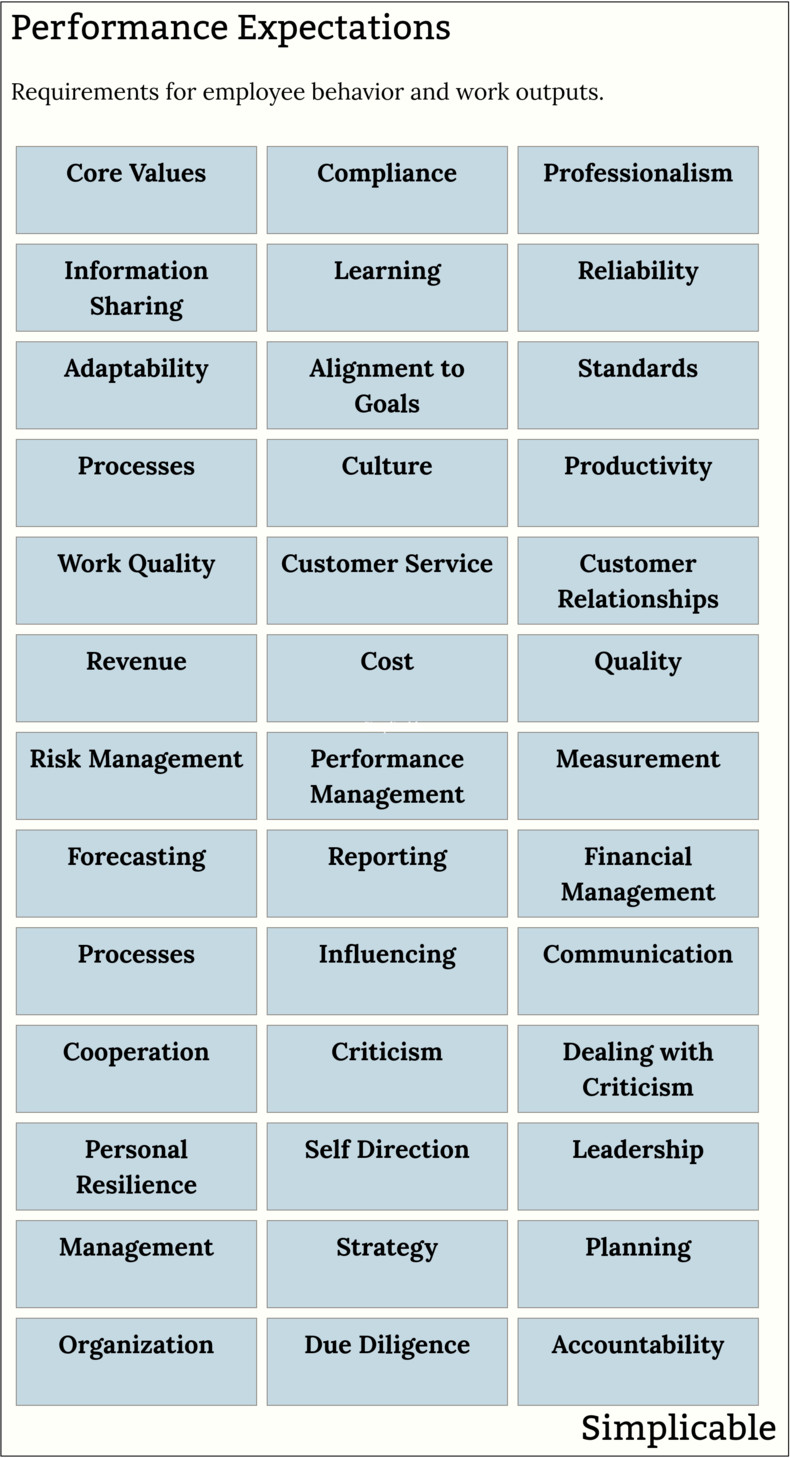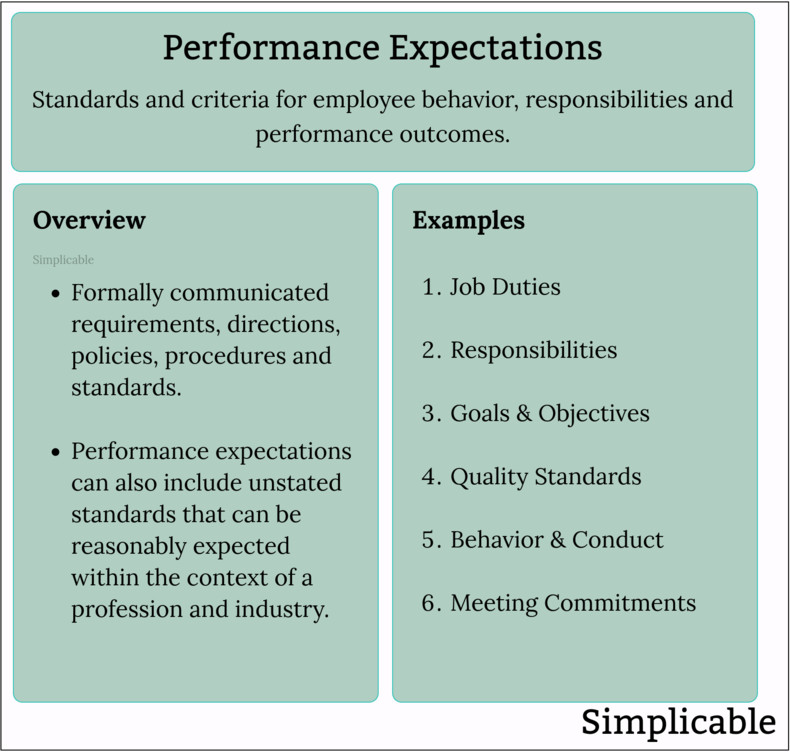Core Values
A requirement to conform to the core values of an organization and team.Live up to our core values.
Compliance
Compliance to laws, regulations, standards and policies.Manage your responsibilities in compliance with applicable laws, regulations, standards and internal policies.
Professionalism
Adhering to the norms of a profession in areas such as personal hygiene, attire, behavior, ethics, diligence and best practices.Reply to stakeholder inquiries in a timely and professional manner.
Candor
Being honest and forthcoming with valuable information.Share information. Be honest.
Learning
Continuing to develop talents and acquire knowledge.Learn to use the new enterprise resource planning tool and become full productive with the technology within two months.
Reliability
Reliability is the quality of being available and performing consistently.Respond promptly to stakeholder inquiries and deliver to commitments.
Adaptability
The ability and will to embrace change and learn. This can be contrasted with resistance to change and irrational defense of the status quo.Support programs of change and keep up with the pace of change in the organization.
Alignment
The expectation that an employee work towards an organization's strategy as opposed to pursuing their own agenda.Align your strategy, decisions and actions to the strategy of the organization.
Standards
Compliance with applicable standards both external and internal.Comply with our procurement standards.
Processes
Adherence to current processes and procedures.Enter detailed customer contact, proposal and service data in a timely and diligent manner.
Culture
Following the norms of an organization, profession or domain.Adhere to the expectations and norms of our software development culture.
Tools
Using the tools adopted by an organization as opposed to introducing new complexities such as proprietary software without approval.Use the software, hardware, toolsets, vehicles, machines, facilities and infrastructure that has been provided by the organization. Do not introduce new tools without gaining appropriate permissions.
Productivity
An expectation for work throughput.Produce a significant volume of work each week and be prepared to demonstrate your recent results.
Work Quality
Work quality is the value of work produced by an individual or team.Produce high quality designs with a client satisfaction rate of at least 85%.
Customer Service
Delivering helpful and friendly customer service.Adhere to our customer service principles such as handling complaints as opportunities to impress the customer.
Customer Relationships
Developing and sustaining relationships with customers.Contact corporate customers at least once a month and resolve their problems and questions in a timely manner.
Revenue
Revenue related performance targets.Achieve sales quota of 12,000 in monthly recurring revenue.
Cost
Principles or objectives related to controlling and reducing cost.Perform due diligence in selecting and managing suppliers to secure the best available cost relative to value.
Quality
Quality is the perceived value of products, services and experiences in the eyes of customers or users. Many organizations depend on a reputation for quality for their survival and may expect employees to prioritize quality in every decision and action.Prioritize product and service quality in your work.
Risk Management
The requirement to identify, analyze and treat risk.Identify, analyze, communicate and treat project risk.
Performance Management
Performance management is the process of setting objectives for each team and individual contributor in an organization and then managing performance against those objectives.Set performance objectives with each member of your team on an annual basis and continually manage performance against these objectives.
Measurement
The expectation that business results be measured and improved using techniques such as management accounting.Continually monitor customer order turnaround time to improve average results and handle exceptions such as delayed orders.
Forecasting
Predicting and estimating future values.Reporting
Communicating measurements, forecasts, status and analysis in a consumable format for a target audience.Develop, deliver and operate an application health dashboard for business units.
Financial Management
Diligence in the planning and administration of finances.Develop a business plan for proposed spending initiatives that includes a complete return on investment analysis.
Processes
A requirement to follow a process.Adhere to the IT governance process for procuring and developing new infrastructure, systems and tools.
Influencing
The expectation that a contributor will build relationships and influence stakeholders in order to gain support for a team's objectives.Represent the sales team in the sales and operations planning meeting to achieve buy-in for sales campaigns and targets.
Communication
Communication related objectives and principles.Develop an action plan for all initiatives and communicate to stakeholders to publicize our efforts.
Cooperation
A requirement to work in the interests of the business as opposed to engaging in negative politics that create risk and needless expense.Work collaboratively with the marketing team to align sales and marketing strategy.
Criticism
A requirement that valuable criticism be offered with candor.Be candid with criticism where it is relevant and valuable.
Dealing with Criticism
The expectation that an individual handle criticism well by calmly defending themselves where it is unfair and accepting fair criticism.Navigate intensive office politics to achieve objectives and maintain composure in the face of criticism.
Saving Face
A principle that employees not seek to embarrass or disrespect each other.Criticize the idea not the person. Be nice.
Personal Resilience
Personal resilience is the ability to handle stress, ambiguity and risk without losing your composure or motivation.Handle stress, ambiguity, change and risk without losing your enthusiasm or professional composure.
Self Direction
Self direction is the ability to find your own way without anyone holding your hand.Demonstrate initiative by finding answers, clearing issues, making decisions, building relationships, developing strategy, planning and implementing work with minimal direction.
Leadership
Leadership is the ability to get people moving in the same direction and working towards a common purpose. This can be done without formal authority.Take the lead to troubleshoot problems, identify root cause and achieve buy-in for proposed solutions.
Management
Management is the control of resources and direction of teams.Manage a sales team to build customer relationships, close sales and improve retention of customers and talent.
Strategy
The development and implementation of strategy.Develop and deliver a strategy to dramatically reduce the carbon footprint of our operations.
Planning
Planning is the process of making strategies, decisions and requirements a reality.Develop a project plan for the data center redesign initiative.
Organization
Organization is the orchestration of people and resources to achieve a result.Organize the annual kick-off meeting by gathering and implementing requirements from the corporate communications team.
Due Diligence
Due diligence is the level of care that can be reasonably expected of a task.Perform due diligence in the hiring of employees.
Accountability
The expectation that an individual own their mistakes. This requires an environment where mistakes aren't overly punished and risk taking is rewarded. Otherwise employees may avoid making any decisions at all.Own your mistakes.
Risk Taking
The expectation that an employee take risks such as making clear decisions without any attempt to cover up accountability.Lead, drive aggressive change and defeat complacency.
Fail Well
Fail well is the principle that strategies and decisions be designed to anticipate and minimize potential failures. For example, experimenting with a new product as opposed to producing a million units before you know how they are perceived by customers.Fail safe, cheap and quick.
Innovation
The expectation that an employee seek leaps forward as opposed to small improvements or copying the competition.Develop products that change industries and challenge larger competitors for market share.
Sustainability
Stewardship of resources and the principle that you will not have a negative impact on planet or people. Sustainability also includes the notion that an organization be built to survive for the long term in the interests of stakeholders such as investors, employees and communities.Do no harm to people, planet or the long term viability of our organization.
Types of Performance Expectations
The following are common types of performance expectations.
Summary
Performance expectations can be communicated formally but can also include reasonable expectations of a profession and industry.
| Overview: Performance Expectations | ||
Type | ||
Definition | Requirements of an employee including expected results, behavior and actions. | |
Related Concepts | ||








































